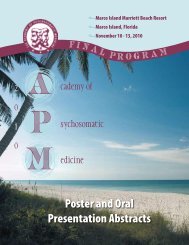Table of Contents - Academy of Psychosomatic Medicine
Table of Contents - Academy of Psychosomatic Medicine
Table of Contents - Academy of Psychosomatic Medicine
Create successful ePaper yourself
Turn your PDF publications into a flip-book with our unique Google optimized e-Paper software.
Oral Presentations<br />
Saturday, November 14, 2009<br />
10:00 AM – 12:00 PM<br />
GROUP A<br />
1. 2008 Webb Fellow: Gene X Environment<br />
Interaction in <strong>Psychosomatic</strong> <strong>Medicine</strong><br />
Presenting Author: Gen Shinozaki, MD<br />
Purpose. There is increasing interest and research related<br />
to gene x environment interactions in patients with conditions<br />
treated by <strong>Psychosomatic</strong> <strong>Medicine</strong> psychiatrists. The<br />
gene x environment interaction is uniquely important at the<br />
interface between psychiatric and medical illnesses (e.g.<br />
depression in cancer patients) and when somatic symptoms<br />
are influenced by psychological trauma (e.g. increased body<br />
mass index (BMI) or heart rate (HR) associated with child<br />
abuse history, (1, 2)). Stressful life events, such as remote<br />
history <strong>of</strong> child abuse, are associated with higher prevalence<br />
<strong>of</strong> depression and other psychiatric characteristic such as<br />
suicidal attempt (2). Similarly to such environmental factors,<br />
genetic factors play roles in the development and presentation<br />
<strong>of</strong> primary psychiatric disorders. Child abuse history and<br />
serotonin transporter gene promoter polymorphism (5HTTL-<br />
PR) status are related in interactive ways with the probability<br />
<strong>of</strong> depression (4). It was hypothesized that the reported association<br />
between BMI, HR, and child abuse history could be<br />
modulated by 5HTTLPR status in a similar manner. The aim<br />
<strong>of</strong> this study was to investigate the influence <strong>of</strong> this hypothesized<br />
interaction on the psychiatric characteristics, physiological<br />
measures (e.g., HR, BMI), and medical comorbidities<br />
(e.g., diabetes mellitus prevalence) among depressed<br />
psychiatric inpatients.<br />
Methods. Retrospective chart review was conducted on 185<br />
Caucasian female patients hospitalized for depression on the<br />
Mayo Clinic Mood Disorders Unit from 2005-2007 who were<br />
also genotyped for 5HTTLPR. We focused on this population<br />
in order to avoid confounding ethnic genotype stratification<br />
issues and gender differences in physiological and<br />
metabolic pr<strong>of</strong>iles. Patients’ medical and psychiatric characteristics<br />
were recorded, including past child abuse history<br />
(physical, sexual, or emotional), current psychiatric diagnosis<br />
(including personality disorder), past suicide attempt history,<br />
resting HR on admission, BMI, fasting glucose level, and<br />
chronic medical diagnoses. The subjects were divided into 2<br />
groups, 1) long/long (l/l) genotype, and 2) any short genotype—i.e.,<br />
short/short (s/s) and short/long (s/l) genotypes<br />
combined. Each genotype group was further divided into two<br />
sub-groups based on the history <strong>of</strong> child abuse for statistical<br />
analysis, and for each characteristic, Fisher’s Exact Tests<br />
were used to analyze categorical data. T-tests were used for<br />
continuous data. Level <strong>of</strong> statistical significance was set at<br />
0.05 though trends are reported.<br />
Results. 98 patients (53.0%) had child abuse history. We<br />
found that, among patients with the l/l genotype, patients<br />
37<br />
with abuse history had a higher rate <strong>of</strong> past suicide attempts<br />
(71% versus 29%, p=0.0010), higher average heart rate on<br />
admission (83.2 bpm versus 73.6 bpm, p=0.013), higher<br />
prevalence <strong>of</strong> diabetes (14.3% versus 0%, p=0.06), and<br />
higher BMI (32.3kg/m 2 versus 27.3kg/m 2 , p=0.031). Patients<br />
with the short allele (s/s or s/l) did not have significant differences<br />
based on abuse history on study measures.<br />
Conclusions. The interaction between the l/l 5HTTLPR<br />
genotype and abuse history in these inpatients was associated<br />
with past suicide attempts, faster heart rate, a trend<br />
toward higher prevalence <strong>of</strong> diabetes, and higher BMI--in the<br />
obesity range. Contrary to the widely recognized “reactivity”<br />
associated with the short allele <strong>of</strong> 5HTTLPR, our Caucasian<br />
female depressed psychiatric inpatients with the l/l genotype<br />
showed distinct clinical pathology compared with other 5HT-<br />
TLPR genotype groups when there was a history <strong>of</strong> child<br />
abuse. Potential reasons for this seeming paradox will be<br />
discussed.<br />
References.<br />
1. Heim C, Newport DJ, Heit S, Graham YP, Wilcox M, Bonsall<br />
R, Miller AH, Nemer<strong>of</strong>f CB., Pituitary-adrenal and autonomic<br />
responses to stress in women after sexual and physical<br />
abuse in childhood., JAMA. 2000 Aug 2;284(5):592-7.<br />
2. Gilbert R, Widom CS, Browne K, Fergusson D, Webb E,<br />
Janson S., Burden and consequences <strong>of</strong> child maltreatment<br />
in high-income countries., Lancet. 2009 Jan 3;373(9657):68-<br />
81.<br />
Caspi A, Sugden K, M<strong>of</strong>fitt TE, Taylor A, Craig IW, Harrington<br />
H, McClay J, Mill J, Martin J, Braithwaite A, Poulton R. Influence<br />
<strong>of</strong> life stress on depression: moderation by a polymorphism<br />
in the 5-HTT gene. Science. 2003;301:386-389.<br />
2. 2008 Webb Fellow: Exploring Providers<br />
Decisions about Delaying or Suspending<br />
Antiretorviral Therapy<br />
Presenting Author: Christopher Kogut, MD<br />
Purpose: For antiretroviral (ARV) medications to successfully<br />
suppress the HIV virus and avoid contributing to viral<br />
resistance, patients must maintain strict adherence with their<br />
treatment regimens. Despite a growing literature on predictors<br />
<strong>of</strong> adherence to ARVs, the literature has not addressed<br />
how practitioners make decisions about when therapy is appropriate<br />
when impeding factors are present. The goal <strong>of</strong><br />
this pilot study is to elucidate which factors are most important<br />
to practitioners in determining when to delay the initiation<br />
<strong>of</strong> ARV or suspend ARV.<br />
Methodology: An exploratory online survey was constructed<br />
and distributed to a sample <strong>of</strong> local primary HIV providers<br />
as well as to psychiatrists with a specific interest in HIV psychiatry.<br />
Providers were asked to rate the importance <strong>of</strong> various<br />
factors in their decisions to either delay or suspend ARV<br />
therapy. They were also asked to rate their level <strong>of</strong> comfort<br />
with a variety <strong>of</strong> clinical scenarios.<br />
Results: 37 providers completed the survey. 78% <strong>of</strong> providers<br />
had delayed ARVs and 65% had suspended ARVs<br />
when there were psychosocial impediments to adherence.



